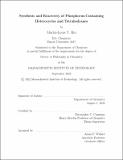| dc.description.abstract | 3,5-Diphenyl-2-phosphafuran (DPF) was synthesized by treating trans-chalcone with dibenzo-7𝜆³ -phosphanorbornadiene EtOPA (A = C₁₄H₁₀, anthracene), a source of ethoxyphosphinidene, followed by formal elimination of ethanol. DPF is a potent diene and readily reacts with dienophiles at room temperature. Mild heating of the corresponding ethylene adduct results in the retro-Diels-Alder reaction.
MesN₂PA (Mes = mesityl), a synthon of mesitylphosphaazide (MesN₂P) and anthracene, was synthesized by treating [Ph3BPA][Na(OEt₂)₂] with [MesN₂]OTf (OTf = CF₃SO₃ −). MesN₂PA reacts with alkynes and phosphaalkynes to form the corresponding [3+2] phosphaazide-(phospha)alkyne cycloadducts and anthracene. Mesitylphosphaazide transfer likely proceeds via a 1,3-dipolar cycloaddition reaction, followed by anthracene elimination.
cis-Macrocyclic diphosphine (PhPA)₂ was prepared by treating [EtOP₂A₂]AlCl₄ with phenylmagnesium chloride (2 equiv). X-ray diffraction analysis of the the corresponding nickel dichloride complex shows the rigid, bowl-shaped cavity of (PhPA)₂.
Tri-tert-butylphosphatetrahedrane (ᵗBuC)₃P was prepared via the dehydrohalogenation of fluorophosphine (ᵗBuC)₃P(F)H. The phosphatetrahedrane core was confirmed spectroscopically and by X-ray diffraction analysis. Hydrogen-hydrogen bonding interactions between neighboring tert-butyl groups of (ᵗBuC)₃P were computationally investigated and contribute approximately −6 kcal/mol of stabilization.
Synthetically useful quantities of (ᵗBuC)₃P were obtained using an improved synthesis based on fluoride-induced trimethylsilyl chloride elimination from chloro(trimethylsilyl)phosphine (ᵗBuC)₃P(TMS)Cl. Despite the incorporation of phosphorus, (ᵗBuC)₃P remains highly reactive and cage-opens to the corresponding cyclobutadiene when treated with catalytic triphenylborane. The proposed reactive intermediate was trapped by styrene and ethylene to form [4+2]-cycloadducts.
(ᵗBuC)₃P also functions as a spring-loaded phosphinidene synthon for nickelcatalyzed group transfer to unactivated alkenes, leading to phosphiranes, three-membered rings that contain a phosphorus atom. Deprotection of the corresponding phosphiranes was achieved by the addition of triflic acid to form a P−H bond and [ᵗBu₃C₃]OTf, demonstrating that (ᵗBuC)₃P can also be viewed as a ‘PH’ synthon.
Tetrahydrofuran (THF) solutions of triphosphatetrahedrane HCP₃ were generated by combining [Na(THF)₃][P₃Nb(ODipp)₃] (Dipp = 2,6-diisopropylphenyl), bromodichloromethane, and INb(ODipp)₃(THF). Removal of solvent under reduced pressure led to a black material that corresponds to a polymerized form of HCP₃. X-ray diffraction analysis of a cationic iron complex of HCP₃ confirmed the tetrahedral nature of the CP₃ core. Computational studies suggest that triphosphatetrahedrane is the least strained tetrahedrane with as mixed carbon-phosphorus core. | |
